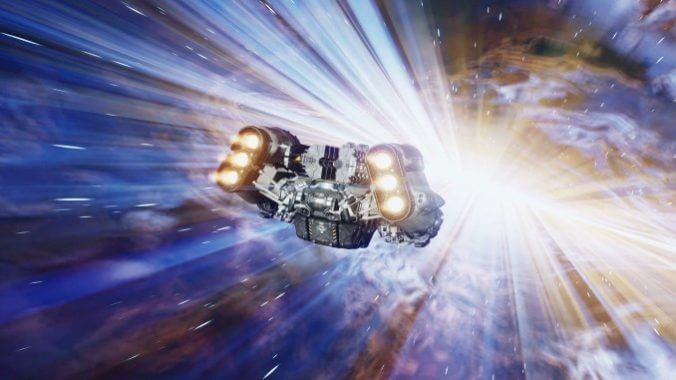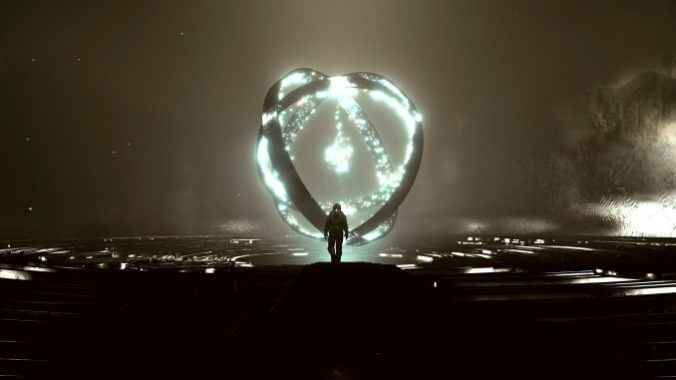Starfield Fails to Launch

Who knew outer space could feel so familiar? Bethesda’s latest RPG, Starfield, entices with the vastness of the universe, boasting of over a thousand planets to visit and hundreds of hours of content to play through. It feels cold, lifeless, and uninspired, though—less a startling or awesome vision of the future than a hodgepodge of obvious influences blended together in the standard Bethesda format. Starfield makes exploring unknown galaxies feel like drudge work.
There are certain things you expect from a Bethesda game, and Starfield pretty much has them all. It’s heavy on story and choice, with a plethora of characters both major and minor, hours of dialogue, and dozens of side-quests branching off of the main thread. There are multiple in-game factions you can choose to join or turn into enemies, and you’ll acquire a coterie of sidekicks and partners who will accompany you anywhere (only one at a time, though, of course). Along the way you’ll routinely make decisions that will have a noticeable impact on the universe and your role in it. Want to play as a persuasive smooth-talker trying to play all sides while avoiding violence as much as possible? Give it a shot. Want to just play like Doom Guy and rip and tear everybody you see? I mean, you can do that, but good luck getting much out of the game if you take that route.
Instead of post-apocalyptic America or an ancient fantasy realm, Starfield takes those Bethesda hallmarks to the stars. You’ll bop around its myriad galaxies, visiting planets and moons and star systems while tracking down the unknown magical artifacts that set the main plot in motion. (The game has a name for these MacGuffins: Artifacts.) These artifacts reveal a grand celestial mystery that could be connected to the afterlife itself—the last undiscovered country left for a human race that, by the game’s setting in the 24th century, has explored the entire cosmos. Each artifact gives its initial discoverer (spoiler: it’s almost always you) a mysterious vision, and as you gradually come to learn what these artifacts mean, you’ll unlock a variety of parahuman abilities, and come into conflict with other parties who want them for their own purposes. The story is all fairly standard stuff, reminiscent of too many other sci-fi games, movies, and books.
There’s nothing fundamentally wrong with that Bethesda format. I’m a fan of Skyrim and the Fallout games the studio has made. Starfield’s major failing is its writing. It lacks the memorable characters of Fallout 4, the compelling mysteries you discover on the edges of Skryim’s main quest, and the strong sense of place of Fallout 3. Your closest partners, the members of an explorer’s group known as Constellation that recruits you after you discover your first artifact, are, with only a couple of exceptions, bland archetypes who you’ll be tired of talking to well before you unravel the mystery of the artifacts. Make sure you regularly cycle out your active partner and the crew members on your ship; if not you’ll hear the same obnoxious lines of dialogue dozens of times. (I never need to hear Barrett’s embarrassing attempts at poetry and profundity upon takeoff ever again.) The only Constellation member that doesn’t quickly grate is a salty old ex-pirate who spends most of his time on a satellite instead of in the mansion that serves as the group’s headquarters; even he doesn’t want to hang out with this crew all that often.
Fallout and Elder Scrolls games are also full of distinctive locations, from friendly cities and settlements to the deadly dens of your enemies. Starfield has its fair share of unique locales, including a handful of cities you’ll probably return to throughout the game. Most of those thousands of planets are at least partially procedurally generated, though, and as a result they trend towards a stultifying sameness that doesn’t make much of an impression. Instead of the gorgeous technicolor wizardry of No Man’s Sky, the typical planet in Starfield is as drab as the game’s characters. You’ll quickly get your fill of gray, green, and brown rocks, often with no flora or fauna upon them; when you do land on a planet with life, it’ll be similar-looking vegetation throughout, and animals that tend to resemble a few basic forms. (One of Starfield’s defining story beats is that no higher alien life forms have been discovered in its universe; it’s just the successors of Earth people spread out in every galaxy, and whatever little weirdo varmints evolved on each rock.) Occasionally you’ll stumble upon an interesting creature, like a race of brains atop tentacles, or dinosaur giraffes who are basically invisible, but those have been rare. Even planets that are colorful and with diverse native life have a touch of the same flat, enervating dreariness that Bethesda games sometimes fall into.
Oh, and there’s so much random junk you can pick up. Almost as soon as the game starts up you’ll be rifling through drawers and cabinets in outer space offices, deciding whether you need to pocket these completely useless pens and folders and notebooks.If you’re favorite part of a Bethesda game is the sheer volume of unnecessary trash you can collect for absolutely no reason, you will love Starfield.

Despite all that, the simple act of exploring is probably the best thing about Starfield. Trekking across new planets while trying to scan the native life for your records feels more rewarding than shooting your way through a gang of pirates at an abandoned science station (something you’ll do a lot of), even if none of that data you collect really means anything. It’s the same elemental “gotta collect ‘em all” mentality that games are dangerously good at tapping into, and whenever I land on a planet with life I struggle with staying focused on the task at hand instead of running around scanning all the critters and plants. If I wasn’t playing this game for review, and thus trying to get through that main story, I’m sure I’d have spent weeks just aimlessly visiting planets and satellites. The worst thing about exploring in Starfield is that once you land you have to do it all on foot. Your ship can’t fly within a planet’s atmosphere, so instead of zooming around in the sky while looking for interesting spots below you’ll have to either hoof it or enter back into space before settling back down elsewhere on the planet. Both are annoyingly time-consuming.
Exploration might be the game’s key, but it’s 2023, so obviously combat has to be a major part of it. Starfield is the closest Bethesda Game Studios has gotten to a true shooter. It doesn’t have the time-pausing VATS gimmick of Fallout or the collection of medieval weaponry at the heart of The Elder Scrolls; you’ll carry an arsenal’s worth of rifles, pistols, shotguns, lasers, and more as you scurry through the universe, and when you have to use them it’s in real time. It’s the most modern and satisfying combat you’ll find in a Bethesda RPG, and perhaps the biggest break from the studio’s format in Starfield. It’s not trying to be Call of Duty, of course, but shooter fans who didn’t like the sluggish, more deliberate combat of Fallout will probably be happy.
You don’t just shoot stuff on the ground in Starfield. You’ll shoot stuff in space when you occasionally dogfight with other ships between planets. It takes a different skill set than first-person shooting, and scratches an entirely different itch in the process. Twirling around in orbit while trying to out-maneuver your enemies is exciting in a fast-paced way Bethesda games almost never are, and while I wouldn’t call it difficult, it’s the most challenging part of the game.
Every gun has multiple slots for mods and updates, which is in line with the game’s focus on crafting and customization. Your most important pieces of gear—your weapons, spacesuits, helmets, and packs—can all be upgraded and modified with equipment you can build at different research stations. You’ll have to be patient—you’ll need to unlock different levels of modding in the game’s skill tree to access more complex blueprints, as well as scrounge up a deep collection of resources and random bric-a-brac on your journeys in order to craft. You’ll also need access to a handful of different research stations, some of which can be built on your ship, with others placed in your outposts (more on those soon) or found at Constellation headquarters. Crafting can be aggravating because of one of Bethesda’s most trademark petty annoyances: your character has a weight limit on how much they can carry, and you’ll be juggling your inventory from the first few hours all the way through New Game Plus. Your ship also has an inventory and it, too, will fill up quickly.
